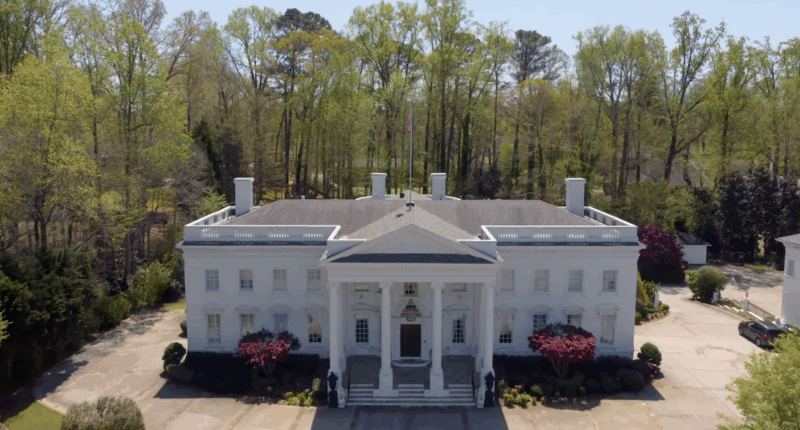Let’s pretend you’ve always dreamed of living in the White House. That is not a crazy dream. Who wouldn’t want to wake up in the Lincoln Bedroom, sip coffee on the Truman Balcony, then walk over to the Oval Office and spend the day working from the Resolute Desk? And when the day is done, you slip into black tie attire and entertain friends and dignitaries in your own 250-person banquet hall.
If that’s your dream, but you prefer not to deal with the hassles of a presidential campaign, debate prep, endless fundraising, and Secret Service agents trying to keep you alive, I have some good news. There is a hack.
You just have to accept one small compromise. Instead of living at 1600 Pennsylvania Avenue in Washington, D.C., you’re gonna have to make do living at 3687 Briarcliff Rd NE, in the Atlanta suburbs. Oh, and you’ll need $35 million.
The Atlanta White House
The story of Atlanta’s White House began long before the first column went up. It started in 1979, when Iranian-born developer Fred Milani arrived in the United States. That year, the shah of Iran was deposed, the Islamic Revolution swept the country, and thousands of Iranians fled in search of safety and stability. Milani was one of them. He settled in Atlanta, rebuilt his life from scratch, and eventually found success buying modest ranch homes and replacing them with the oversized, high-columned properties that came to define the region’s McMansion boom.
By the late 1990s, Milani was a full-force developer with dozens of large homes under his belt. In October 1999, he purchased a quiet lot in Oak Grove for $180,000. According to Milani, the idea for the White House took shape almost instantly. His wife told him she wanted a grand house with columns. His architect, half joking, said, “Well, if you want columns, why not just build the White House?” Milani had undergone a conversion to Christianity a few years earlier and interpreted the suggestion as a sign. “I believe it was Jesus’ plan,” he later told CNN. Within minutes, the decision was made.
Construction finished in 2001, and the result was not a loose homage. Milani built a sincere, detailed re-creation. The property included a roughly 16,500-square-foot main residence and a matching 7,500-square-foot guesthouse. Inside, the Oval Office featured a Resolute-style desk, two open Bibles, and a presidential seal on the ceiling. The Lincoln Bedroom included a hand-painted mural of Abraham Lincoln. The front yard displayed an illuminated cross surrounded by topiary spelling out “God ♥ You.” A domed ceiling near the entrance depicted Jesus ministering to people from around the world, including a man in a sombrero and an American Indian in full headdress. At Jesus’s feet, the painter added Milani himself, kneeling.
It was part political funhouse, part religious sanctuary, part personal statement. Neighbors couldn’t agree on whether it was charming, tacky, or simply too large for the neighborhood. But curiosity traffic quickly became a daily occurrence. People slowed down to take photos. Some complained about zoning fights and Milani’s growing McMansion footprint. Others admired the ambition.
By the mid-2000s, the Atlanta White House wasn’t just another oversized property. It was a full-on local landmark, a surreal symbol of Atlanta’s boom years and the blending of Milani’s immigrant story, new faith, and real estate ambitions. Here is a video tour of the Atlanta White House:
And here’s a video tour from when the home was featured on an episode of an HGTV series back in 2012:
Financial Troubles Brew
By the mid-2000s, the Atlanta White House had become a neighborhood curiosity, a local photo-op, and a kind of personal monument for Fred Milani. But behind the scenes, the timing could not have been worse. Atlanta was one of the cities hit hardest by the real estate collapse, and Milani’s entire business model depended on a steady flow of buyers willing to pay premium prices for oversized new construction. When the market seized up, his empire seized up with it.
According to a 2009 article in The New York Times, Milani entered the downturn carrying multiple speculative homes, several delinquent loans, and a shrinking pool of buyers. His bank twice attempted to foreclose on the White House replica, and both times he narrowly avoided losing the property by restructuring debt, including a $1.75 million past-due loan. At the same time, he was racing to sell off other homes simply to stay afloat.
Then came November 2008, arguably the worst moment in the American housing market in the last century. Credit evaporated, demand plunged, and luxury real estate became nearly impossible to move. It was in this exact climate that Milani listed the Atlanta White House for an extremely optimistic $9.8 million. The timing could not have been more brutal. No buyers came forward.
By 2013, after sitting on and off the market for years, the reality of the situation became unavoidable. The Milani family finally accepted an offer of $2.2 million in November 2013, a staggering drop from the original asking price and a reflection of just how far the market — and Milani’s finances — had fallen since the boom years.
The Current Owners
The buyer who stepped in after the Milani years was Thuy Ai Kathy Lam. As she recounted to the Wall Street Journal, Lam was born in Vietnam shortly before the end of the war. After her father, a general in the South Vietnamese army, was imprisoned by the Communist regime, she spent her early teens painting nails door to door to help support her family.
In 1995, the United States sponsored her family’s move to Atlanta. Lam arrived with almost no money, learned English, became a nail technician, and made herself a promise that her family would never struggle financially again. Nine months later, she used a loan to open her first nail salon. That small business grew into a nationwide network of salons and beauty schools, including the Atlanta Beauty & Barber Academy, which she founded in 2005 and continues to run today.
In the summer of 2013, Thuy and her then-husband, Daniel Nguyen, were searching for a larger home. One night, they drove past the Atlanta White House. Nguyen joked they should buy it. Lam didn’t laugh. She knew the seller’s son and immediately reached out to see if a deal was possible. The timing worked. After years of financial strain and multiple failed attempts to sell the house, the Milani family accepted $2.2 million for the property in November 2013.
Lam embraced the estate with a mix of reverence and gratitude. She raised her children there, kept the Oval Office intact, hosted community Christmas events, and even rented out the seven-bedroom guesthouse as an Airbnb she called the “West Wing.”
Now that her children are grown and off to college, Lam has decided it is time to downsize. This week, Thuy listed the Atlanta White House for $35 million. That price makes it the most expensive residential listing in the Atlanta metro area, and if she sells for anywhere near that amount, it will obliterate the home sale record for the Atlanta suburbs.
Do I think she’ll get $35 million? No.
I just spent some time on Zillow scoping out the most expensive homes sold in the Atlanta suburbs from the last few years. I found an interesting comp.
In March 2024, a 20,000-square-foot mansion set on a 3.4-acre lot in Tuxedo Park, roughly 20 minutes from the Atlanta White House, was listed for $20 million. Described as a “custom Scandinavian Modern Masterpiece,” this mansion is stunning. It has every single modern feature an extremely rich suburbanite would desire. It’s also located directly next door to the Governor’s mansion, which is a nice safety perk. This home is incredible. I’ve included a video tour below. This mansion sold in February of this year for $15.7 million. Is someone really going to pay more than 2X that amount for a White House replica set on a third of the land that previously sold for $2.2 million, a bit over a decade ago? Meehhhh.









